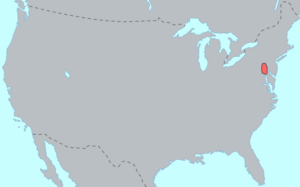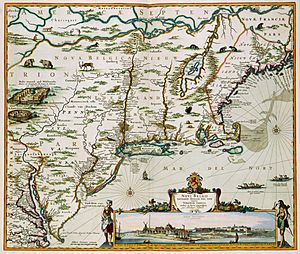Susquehannock facts for kids

Historical Distribution of the Conestoga Language (Susquehannock)
|
|
| Total population | |
|---|---|
| Historically estimated 3,000-20,000, now extinct as a tribe | |
| Regions with significant populations | |
| New York, Pennsylvania, Maryland | |
| Languages | |
| Conestoga Language (Susquehannock) | |
| Religion | |
| Native, Protestant, Roman Catholic, Orthodox Christian | |
| Related ethnic groups | |
| Iroquois (Haudenosaunee), Erie people, Neutral Nation, Huron peoples (Wyandot), Wenro, Tabacco peoples, Tuscarora, & Cherokee |
The Susquehannock people were Native Americans who spoke an Iroquoian language. They lived in the areas around the Susquehanna River and its smaller rivers. Their lands went from southern New York through eastern and central Pennsylvania. They also lived in Maryland along the west side of the Potomac River near the Chesapeake Bay.
Signs of their homes have also been found in northern West Virginia and parts of southwestern Pennsylvania. These areas could be reached through mountain passes like the gaps of the Allegheny. Their large settlement at Conestoga, Pennsylvania was also connected to these paths.
Contents
What Language Did the Susquehannock Speak?
The Susquehannock people spoke an Iroquoian language. Not much of their language has been saved in writing. The main source is a list of about 100 words put together by a Swedish missionary named Johannes Campanius in the 1640s.
This list shows that Susquehannock was a Northern Iroquoian language. It was very similar to the languages spoken by the Iroquois Confederacy. It seems to have been closely related to the language of the Onondaga Nation. The Susquehannock language is considered extinct since 1763. This was when the last known speakers were killed by the Paxton Boys.
How Did the Susquehannock Get Their Names?
European explorers often learned the names of inland tribes from the Algonquian-speaking peoples living along the coast. The Europeans then changed these names to fit their own languages and spelling. We do not know what the Susquehannock called themselves.
Here are some names they were called:
- The Huron, another Iroquoian-speaking group, called them Andastoerrhonon. This meant "people of the blackened ridge pole," referring to their building style.
- The French used the Huron term and called them Andaste or Gandastogue.
- The Lenape, an Algonquian-speaking people, called them Mengwe. This word might have meant "treacherous." Dutch and Swedish colonists used this term, calling them Minquas.
- The Powhatan-speaking peoples in Virginia called the tribe the Sasquesahanough.
- The English settlers in Maryland and Virginia used the Powhatan term, calling them the Susquehannock.
- Later, British colonists in Pennsylvania called them the Conestoga. This name came from a village called Conestoga Town. Its name, Kanastoge, possibly meant "place of the upright pole."
History of the Susquehannock People

Life Before Europeans Arrived
Around 1450, the Susquehannock lived on the North Branch of the Susquehanna River. By 1525, they moved downriver to what is now Lancaster County, Pennsylvania. Here, they lived in larger villages.
The Susquehannock told Europeans they originally came from a big river valley to the west. They also said they joined with other groups east of the Appalachian Mountains to form their nation. Both stories are likely true.
In 1600, there were probably as many as 7,000 Susquehannock people. They were the most numerous group in the Susquehanna Valley. It is believed they had lived in these lands for thousands of years.
First Meetings with Europeans
English colonists did not often visit the upper Susquehanna River early on. When John Smith met the Susquehannock in 1608, they had a large town in the lower river valley. Smith wrote that they could have "neere 600 able and mighty men." He noted their towns were protected by fences called palisades. He was surprised to find them trading French goods.
Like the Haudenosaunee (Iroquois Confederacy), the Susquehannock were made up of several different tribes. John Smith named some of their main towns:
- Sasquesahanough
- Attaock
- Quadroque
- Tesinigh
- Utchowig
- Cepowig
The French explorer Samuel Champlain wrote about the Susquehannock in 1615. He described a Susquehannock town called Carantouan as "strongly fortified." It had "high and strong palisades" and more than 800 warriors. Carantouan was located near present-day Waverly, New York.
Historians believe the Susquehannock population was between 5,000 and 7,000 in 1600. They were powerful enough to fight off the Haudenosaunee for many years. The Susquehannock allied with Dutch and Swedish traders early on. These traders supplied them with flintlock firearms, which made the Susquehannock even stronger.
Before 1640, the Susquehannock may have defeated some groups of the Lenape. The Lenape then became a group that paid tribute to the Susquehannock.
Wars and Alliances
The Susquehannock traded furs with the Europeans. They allied with the Swedes, who traded firearms for furs. The Susquehannock often disagreed with the new European leaders of the Maryland and Pennsylvania colonies.
From 1642 to the 1650s, the colony of Maryland declared war on the Susquehannock. With help from their Swedish allies, the Susquehannock won this war.
In the mid-1600s, the Susquehannock traded furs for European firearms with English traders. This made the Haudenosaunee start fighting other groups to control the fur trade. Around 1666, the Susquehannock won a big victory against the combined forces of the Seneca and Cayuga nations. This greatly weakened these western Iroquois groups.
The Susquehannock were strongest in the early 1670s. However, their population then dropped very quickly in the mid-1670s. This was likely due to infectious diseases like smallpox. These diseases also harmed other Native American groups. By 1678, the Haudenosaunee defeated the weakened Susquehannock. Some small groups may have moved west into the Ohio Country. Others were likely absorbed by the Shawnee.
In 1652, six Susquehannock chiefs made a peace treaty with Maryland. They gave Maryland large areas of land around the Chesapeake Bay. In return, they received weapons and safety on their southern border. This was also because of the Beaver Wars of the 1650s. During these wars, the Haudenosaunee moved south and west to expand their hunting grounds. With Maryland's help, the Susquehannock fought off the Iroquois Confederacy for a while.
From 1658 to 1662, the Susquehannock were at war with the powerful Haudenosaunee Confederacy. By 1661, Maryland and the Susquehannock had a full alliance against the Haudenosaunee. In 1663, the Susquehannock defeated a large Haudenosaunee invasion force.
In 1672, the Susquehannock defeated another Haudenosaunee war party. In 1675, the Susquehannock suffered a major defeat by the Haudenosaunee. English colonists invited the tribe to move to the colony of Maryland. This area was already part of the Susquehannock homeland.
The Susquehannock then got caught up in Bacon's Rebellion in Virginia. After some Doeg Indians killed some Virginians, colonists from Virginia killed Susquehannock in return. A group of Susquehannock moved to a fort on Piscataway Creek. When five Susquehannock Chiefs came out to talk, the colonial militias killed them. The Susquehannock left their village and later returned to the Susquehanna River area.
The Covenant Chain Treaty
In 1676, the Haudenosaunee made peace with Maryland, Virginia, and the Lenape. When the Susquehannock agreed to the Covenant Chain treaty with the Haudenosaunee in 1679, they were offered protection.
Around 1679, most of the remaining Susquehannock moved to New York. They joined mainly with the Seneca and Onondaga nations, who also spoke Iroquoian languages. The Haudenosaunee often adopted defeated enemies into their tribes. The Governor of New York welcomed the Susquehannock.
Some Susquehannock returned to their homeland on the southern Susquehanna River. Others moved to the upper Delaware River. Some survivors joined with the Meherrin and Nottoway tribes in Virginia and North Carolina.
Archaeological sites in eastern West Virginia show evidence of Susquehannock movement and living there.
The Susquehannock chiefs never gave their lands to Europeans or Americans. The Covenant Chain treaty prevented them from doing so.
Conestoga Town and Its End
The Susquehannock population in their homeland dropped to about 300 people by 1700. Another group lived to the west near what is now Conestoga, Pennsylvania. English colonists called them the Conestoga people.
Diseases and warfare had greatly reduced their numbers. Around 1697, a few hundred Conestoga settled in a new village called Conestoga Town in Lancaster County, Pennsylvania. The river there was named the Conestoga River. A type of wagon, the Conestoga wagon, was later named after them.
The Conestoga people at Conestoga Town were protected by the Pennsylvania government. But their population kept shrinking. In 1763, only twenty-two people lived in Conestoga Town. That year, a group called the Paxton Boys attacked the town. They killed six people.
The remaining Conestoga were given shelter in a building in Lancaster. The governor tried to stop more violence. But two weeks later, the Paxton Boys raided the building. They killed the remaining 14 Conestoga people. The tribe and their language were then considered extinct.
The last two known Conestoga from Conestoga Town, Michael and Mary, were safe on a farm. After they died naturally, they were buried there.
Today, some people with Susquehannock ancestors may be part of the Seneca-Cayuga Tribe of Oklahoma.
How the Susquehannock Lived
The Susquehannock society was a group of up to 20 smaller tribes. They lived in villages spread along the Susquehanna River. Like other Iroquoian-speaking tribes, they likely had clans. Their society was matrilineal, meaning family lines and property passed through the mother.
The Susquehannock stayed independent until the 1670s. But they were not strong enough to fight off both colonists and other Native American nations in the Beaver Wars. Around 1677, many Susquehannock, weakened by disease and war, joined their former enemies, the Haudenosaunee. The Haudenosaunee then took over the Susquehannock territory.
Susquehannock people lived in longhouses, similar to the Haudenosaunee. Their villages were surrounded by palisades (strong fences) to protect them from enemies. Corn was a very important crop for them. They also kept dogs. Other important animals were turkey, deer, bear, beaver, and elk.
Susquehannock men used bows and arrows and war clubs in battle. Smoking tobacco was an important part of their rituals. Their hairstyles were similar to, but different from, the Haudenosaunee.
They traveled by canoe on the water and by trails on land. The Susquehanna River was a main route for trade between their tribes. This river allowed them to be a powerful group in the region. Their homeland had mountains, rivers, and flat lands. They likely hunted the Pennsylvania Bison. Travel between mountain ridges was common. This allowed them to trade with groups from the Southeast, like the Cherokee.
Susquehannock villages were often built on top of mountain ridges. This allowed them to see the surrounding area, which they used for farming corn, beans, and squash. This way of building villages also protected them from enemies and floods. The Susquehannock lived in settled villages and were not nomadic. They likely gathered nuts, berries, and mushrooms from the forests.
Dreams were probably important to the Susquehannock people, as they were for other Iroquoian groups.
Archaeologists have found Susquehannock artifacts in Pennsylvania and Maryland. They have also found evidence of Susquehannock people along the Potomac River.
Legacy of the Susquehannock
Several places are named after the historic tribe:
- Susquehannock State Park in Pennsylvania.
- Susquehannock High School in Southern York, Pennsylvania.
- Place names in the Conestoga homeland reflect words from the Susquehannock/Conestoga language.
A graphic novel and documentary called Ghost River tells the story of the Paxton massacres of 1763. It focuses on the Native American victims and their families.
Images for kids
Related Iroquoian Peoples
- Susquehannock
- Cherokee
- Chonnonton
- Erie
- Huron
- Haudenosaunee Confederacy/Iroquois
- Meherrin
- Mohawk
- Petun
- Tuscarora (Also Nottoway )
See also
 In Spanish: Conestoga para niños
In Spanish: Conestoga para niños






